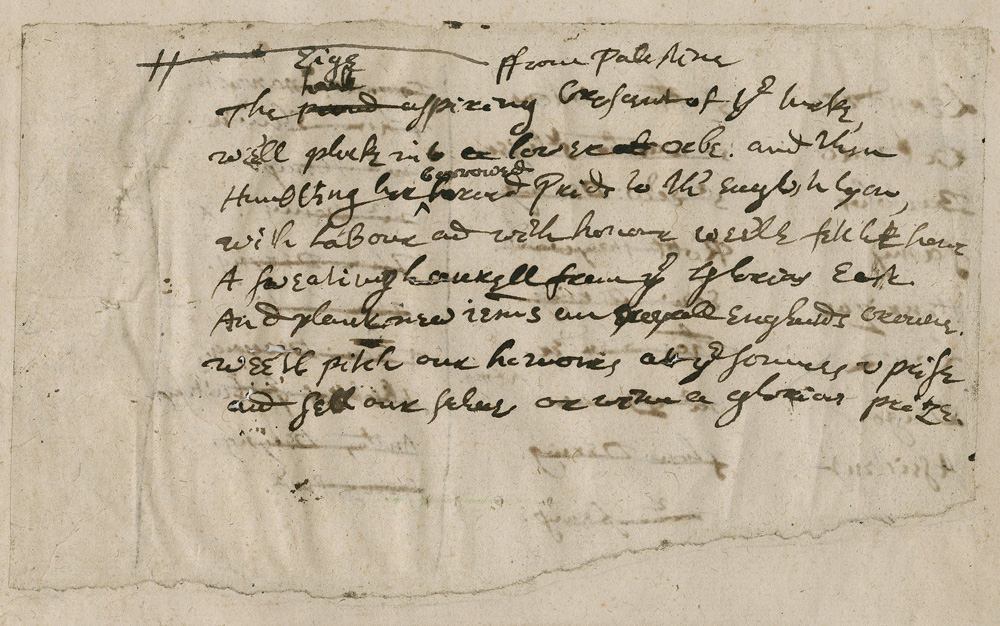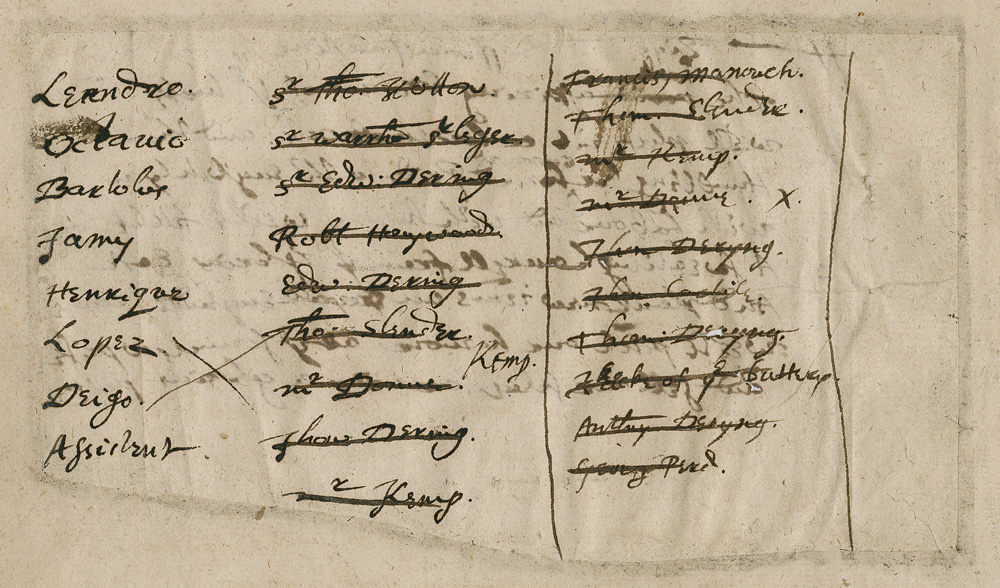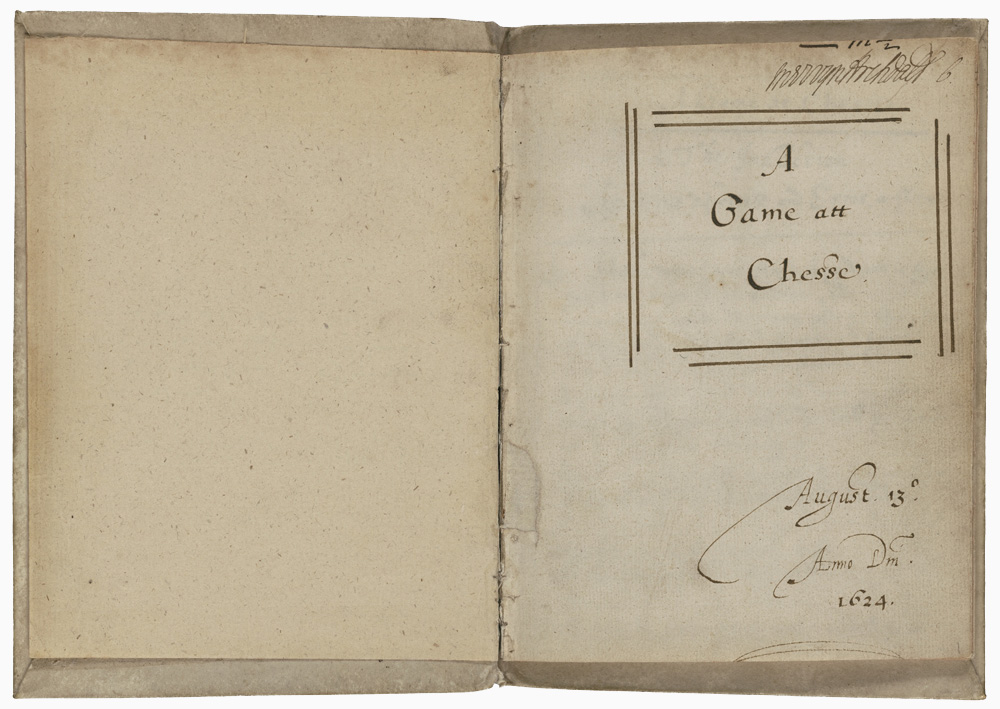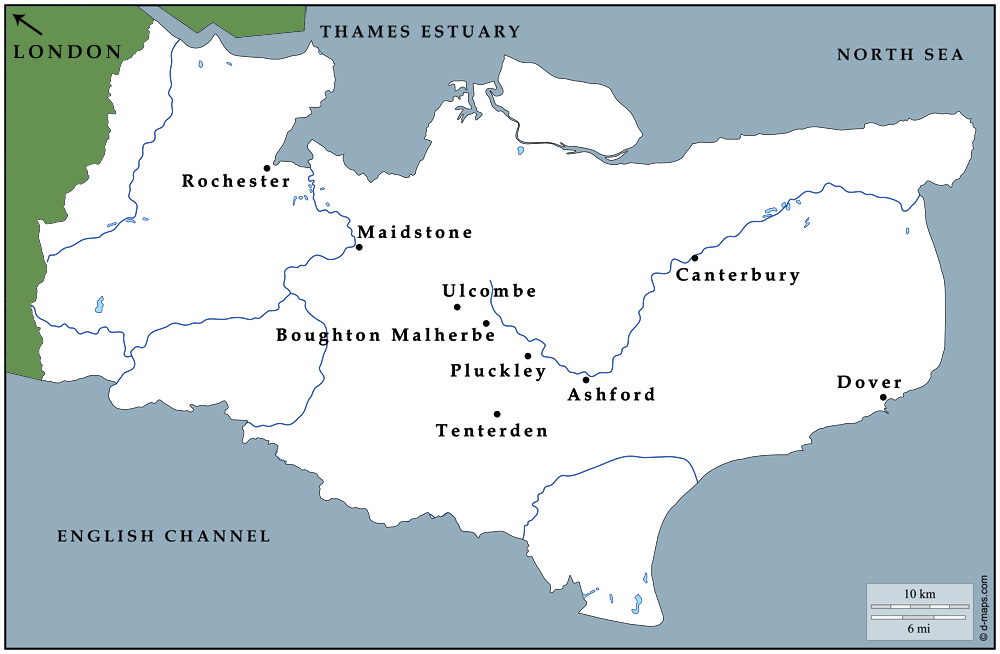4.1 Household Performance
The Spanish Curate Slip
The Spanish Curate slip is a scrap of paper pasted into the first and otherwise blank leaf of the Henry IV manuscript. On one side of it is a list of roles and performers for The Spanish Curate, a play by John Fletcher and Philip Massinger, and on the other side a few lines Dering wrote to expand the opening speech of Henry IV. It is a physical constituent of Dering’s Henry IV and holds part of its text, but it is also the only surviving fragment relating to another performance project. As will be suggested, the list of roles is relevant to Henry IV as well as The Spanish Curate.
Dering himself may have incorporated the slip by mounting it onto a spare leaf of paper from the Henry IV manuscript. The mounting was a precise and delicate task. A window was cut into the leaf that was the exact shape of the scrap but marginally larger. The scrap was then pasted in, with minimal overlap between it and the leaf on which it was now mounted.


The slip has been mounted into an unnumbered and otherwise blank leaf, identified as fol. *, at the beginning of the Henry IV manuscript. A window was cut into the leaf that was the exact shape of the scrap but marginally larger. The scrap was then pasted in, with minimal overlap between it and the leaf on which it was now mounted.

At some unknown time, the list of roles and performers for The Spanish Curate was torn along the bottom edge to separate it from the rest of a quarto-size leaf of paper into which it was originally written. The leaf may have come from a notebook into which Dering had written the list of names. Dering apparently tore out the list to detach it from the rest of its physical context. This is perhaps most likely to have happened immediately before he used the other side of the leaf to write some added lines for Henry’s opening speech in Henry IV. As the slip was torn carefully to keep the integrity of the cast list, it would seem that Dering’s purpose in detaching it was to enable it to be associated with the Henry IV adaptation. It was pasted into a window made in the spare leaf that preceded the first inscribed leaf. There was minimal overlap between it and the leaf on which it was now mounted. Both sides of the slip could therefore be read.
The mounting was a precise and delicate task. As Laetitia Yeandle argues, it may have been undertaken at a later date, for instance in the nineteenth-century when the whole manuscript was bound. But there are reasons for supposing that Dering was responsible. He was experienced in the physical manipulation of inscribed paper. The detachment of the slip from its original context makes no sense unless Dering wished to connect it with Henry IV, and the mounting of the slip physically enacts that connection. If it is right to deduce that Dering undertook the paste-in, he must have been keen to use the list of performers of The Spanish Curate as a template for the casting of Henry IV.
The slip extends the range of plays that Dering intended to have performed in his household. It is crucial not only for understanding the range of Dering’s ambitions as an organiser of amateur performances; it also offers clear evidence of the kind of performances that Dering had in mind.
As for the sequence of inscription, the deletion of performers’ names in the Spanish Curate cast list suggests that it was superseded by the lines for Henry IV. The physical association of the two documents supports the same conclusion, as does the better fit between the inscription and the size of the slip on the Spanish Curate side.
Therefore Dering evidently found the reverse side of the Spanish Curate slip a convenient repository for his added lines. He may have torn the slip from the rest of the leaf specifically in order to re-use the paper. But in that case the integrity of the cast list would have been of no concern and there would be no reason to respect it in making the tear. Moreover, his reuse of the slip cannot be explained in terms of economy, as it would have been far easier to write directly into the leaf onto which the split was mounted than to resort to the slip. Conjecturally, then, Dering deliberately created an association between the cast list for The Spanish Curate and his new project, because he envisaged using a similar range of performers. It would have a comparable kind of oblique relevance to the notes on the geography and legendary history of Thrace and Macedon that are included in his author’s plot for the play often notionally called Philander King of Thrace but more accurately and usefully called Aristocles. The list of performers’ names, however, might have had a more practical utility in developing the project. Why the names of the performers but not the roles are crossed out is not clear, though deletion in itself would be a standard way of showing that the obverse of the slip was not immediately part of the text of Henry IV.
A Spin-off from a Play Staged by the King’s Men
The Spanish Curate was licensed for performance by the King’s Men at the Blackfriars theatre on 24 October 1622, and proved to be especially popular on stage.1 The date of Dering’s plans for staging it fall between late October 1622, when the play would have been first performed in London, and late February 1623, when Dering was working on Henry IV, at which time he recycled the slip to draft a few lines of dramatic verse for the opening scene.
How did Dering obtain a manuscript of the play? No edition had been published. In 1647 Humphrey Moseley, the publisher of the folio volume of plays ascribed to Beaumont and Fletcher in which The Spanish Curate was first issued, explained that “when private friends desir’d a Copy, they then (and justly too) transcribed what they Acted”. As a regular playgoer in London and an affluent gentleman, Dering would have been well placed to request such a copy; indeed it is hard to think of anyone to whom Moseley’s account would more aptly apply. Moreover, The Spanish Curate as Moseley published it appears to have been transcribed by Ralph Crane, the most prolific scribe known to have worked for the King’s Men.2 Crane is the only scribe known to have made multiple copies of one play: his hand is found in three surviving manuscripts of Thomas Middleton’s explosively scandalous satire A Game at Chess, which was performed and closed down in August 1624.

The title page of the Archdall manuscript of Thomas Middleton’s A Game at Chess, transcribed by Ralph Crane. Folger V.a. 231.
Crane also prepared a presentation copy of Middleton’s The Witch, which Middleton dedicated to another patron, “the truely-worthie and generously-affected Thomas Holmes Esquier”. He was particularly active in 1619-1624. Dering would have been exceptionally well placed to request his own manuscript copy of The Spanish Curate, and, although we do not know that he did so and Crane obliged, Crane would have been on hand in London during the period when Dering obtained his manuscript.
The Spanish Curate as published in 1647 does not itself have a list of roles. There is nevertheless a specific textual link between the play as printed and Dering’s list. Both texts name one of the roles as “Assistant”, in the specific and unusual sense of a deputy judge; the word can be seen at the bottom of the left-hand column of the cast list. This word does not occur, in any sense, in the source for the play, Gerardo the Unfortunate Spaniard (1622; Leonard Digges’s translation of Gonzalo de Céspedes y Meneses). The Beaumont and Fletcher folio is only the second example of this particular sense in OED; the first comes from Randall Cotgrave’s Dictionary of the French and English Tongues (1611), and is adduced as a translation of the French legal term assessoriat. “Assistant” is in this sense a piece of highly specialist vocabulary that Dering adopts from Fletcher and Massinger’s play, which therefore mediates between Digges’s Gerardo and Dering’s list.
The inference is simply that Dering would have been exceptionally well placed to obtain his own manuscript copy of The Spanish Curate.
The Proposed Players
Dering compiled the scrap by first writing the names of potential players in two columns and then adding roles to the left of the left-hand column. There are nineteen names in the list as first written, though this figure includes some duplications. The priority given to the performers over the roles is closely linked with Dering’s social modelling of the performance. So too does the sequence of names within that list, which begins with three knights, identified as ‘Sr’.
Dering roughly aligned the end of the first column of performers with the middle of the paper, but the effect was actually to allow a larger left margin than right margin. His inscription of vertical lines to the right of each column of names exacerbated this imbalance. But the effect may not have been accidental, for two reasons. First, Dering’s thoughts were more immediately preoccupied with the performers named in the left-hand column, and so he may have allowed more space to articulate them. Second, the list is based on social hierarchy, and it may have been merely intuitive to allow more space to more elevated personages.
In the space between the roles Lopez and Diego and the performers Slender and Donne there is a large cross. This probably signifies that Dering decided to switch the performers of these roles. His uncertainty continued, for the name “Kemp.” is written to the right of and between these two performers’ names. This awkwardly duplicates “Mr Kemp” in the second column of roles. Thus initially Donne then Slender then Kemp seem to be associated with the role of Diego.
A smaller cross has been placed to the right of “Mr Donne” in the right-hand column. This is presumably a deletion mark, in recognition that the name appears in the left-hand column as well.
The slip offers a compelling opportunity to correlate the players who can be certainly or conjecturally identified with the roles Dering thought they might take on, and to describe the social milieu of Dering’s planned productions.

The Wottons were a prominent family in Kent. This is Thomas Wotton, second Baron Wotton of Marley (1587–1630). He was related to Sir Henry, English ambassador to Venice, and was son of Edward Wotton, the first Baron, diplomat, and Lord Lieutenant of Kent from 1604 to 1620; Edward was associated with the Protestant wing of the King’s Council but was a covert Catholic until he professed himself Catholic in 1624.3
Dering was connected to the Wotton family as a relative, friend, and dependent for patronage.4 He had regular contact with the family. On 19 January 1620 his second wife Anne gave Sir Thomas’s wife Lady Wotton £1 as a christening gift as godmother, and paid the nurse another £1. On 23 June of the same year, and again on 5 December 1623, he bought a case of knives as a gift for Wotton. On 4 December 1620 he sent him six shillings in recompense “for half a doe which sir Thomas Wotton sent”. On 18 December 1622 Dering was intermediary in settling a legacy of £20 from his uncle Edward to Lady Wotton. On 13 March 1623 he paid four shillings “for wine when Sir Thomas Wotton was heere”, and again on 5 May paid 2s 6d “for Rhenish wine att ye stillyard [i.e. London’s Steelyard?] for my lady Wotton”. A few days later, on 12 May, he gave Wotton £1 2s before four witnesses or companions at the Mermaid tavern in the Old Bailey, London, “vpon this Condition that when he is Lord warden of ye Cinque portes I may be his leifetenant”. He again dined with Wotton in London on 4 October, after seeing a play, perhaps together. On 5 October 1623 he accompanied Lady Wotton to see a play in London. From there he travelled north “to meete Sir Thomas Wotton and to bring him home out of Northamptonshire”. In December 1625 Wotton lent Dering his cook for “almost a weeke”. There is an unexplained payment to Wotton of 6d on 21 April 1625. Dering made a gift of 15s “att Sir Thomas Wottons May”, that is, his Mayday festivities. Such details reflect both Wotton’s role as patron and a sustained and close friendship over a number of years.
Marley is about 13 miles east of Pluckley.
Wotton is put down to play Leandro, a lusty young man, in sexual pursuit of Bartolus’ wife Amaranta.

c.1580-1631. Of Ulcombe, Kent. Related to the Irish colonist of the same name of 1525?-97.5 The present Sir Warham helped finance Sir Walter Raleigh’s Guiana expedition, and commanded one of its ships, the Thunder. Financially ruined by the expedition, he was forced to sell Leeds Castle.6 Several of his ancestors fought notably in the Crusades, and Dering’s reference to them on the verso of the cast list itself, and at the end of the play, might be a compliment to him.
Ulcombe is about 5 miles north-west of Pluckley.
To play Octavio, supposed father of Ascanio.

Creator of the document, book-collector, antiquarian, Member of Parliament for Hythe in the 1625 and Long Parliaments. He modestly and correctly lists himself below Wotton and St Leger.
Dering enlists himself to play Bartolus, a rapacious lawyer (named after the famous Italian law professor Bartolo da Sassoferrato, 1313 –57): a good performer’s part.

The surname is transcribed by Evans and Williams as “Haywood”. Dering’s Book of Expenses identifies various Roberts but none explicitly surnamed Haywood. St Leger’s wife was née Mary Haywood or Haward; Robert therefore might be a St Leger family member.
However, Sir Robert Honywood, diplomat and translator, of Petts Court, Charing, is more likely the person intended. He received from Dering and repaid a loan of 13s on 7 October 1623 (“Booke of Expences,” fol. 33v), and had supper with Dering and others in London on 18 November (fol. 34r). Dering’s record describes him as “my cosen Honywood”; also “my Cosen Honywoode” (fol. 40r).
Charing is less than three miles north-east of Pluckley.
To play Jamy, the younger brother, as appropriate to a man of twenty two.

Dering’s uncle Edward died in 1622, so this is the surviving “cosen” Edward Dering of Egerton, Kent. His brother John is also listed in the scrap.
Egerton is less than two miles north-west of Pluckley.
To play Henrique, the elder brother.

Perhaps the servant (groom/footman) called Thomas in the Book of Expenses. “Slender” might be a nickname based on personal appearance, as with Shakespeare’s character in 2 Henry IV.
To play Lopez. Or to play Diego (see the above account of the cross marked alongside these roles).

Almost certainly not the poet.
To play Diego, a sexton; a comic role. Or to play Lopez.

See Edward Dering. He lived at “Myllefont”, a house named four times in the Book, but unidentified. In August 1621 Dering paid John £20 for “a sorrell stone horse”. On several occasions John supplied Sir Edward with malt for brewing beer.
To play the judge’s Assistant.

According to Krivastsky and Yeandle, he was a “playwright.”7 But the Interregnum Royalist playwright was Cosmo Manuche (or, in Italian, “Cosimo Manucci”). Dering’s Manuche is presumably Francesco Manuche, in the service of Sir Edward Wotton, of Boughton Malherbe, Kent,8 diplomat, and father of the Sir Thomas named at the top of Dering’s list. Francesco is not an established relation of Cosmo, though he may have been a cousin;9 he is not known to have written plays.10 This takes out of the picture a putative collaborator who might otherwise have worked with Dering in writing the play: if Manuche is not Cosmo Manuche, we cannot identify any experienced dramatist who might have assisted Dering in his efforts.
Boughton Malherbe is about 3 miles north-west of Pluckley. Dering was a regular visitor.
Francesco left the service of Wotton to serve Viscount Edward Conway in 1624, but may have retained his connection with the Dering family, as Dering’s descendent Edward married “Sarah Manooch” on 12 December 1714.11

According to the Book of Expenses, a “Cosen”, living in John Dering’s household at Myllefont. From Dering’s Book of Expenses we know Dering paid “master Carlile” 2s on 14 March 1619 “for bringinge thinges from Hothfeilde.” Hothfield is a village and manor three miles east of Pluckley.

In early 1618 Dering paid £3 11s for “Dyett and Lodginge att my cosen Thomas Deringe’s”. On 7 May 1623 Dering paid him 12s 10d “for an angle and for fishing lines”, then a further 12s 10d “for horsemeate and letters”. Two months later, on 20 July, Thomas received 10s 6d “for 12 ells of Canuis” (i.e. 45 feet of canvas). Dering gave 2s for staying with him on 26 November.

The Book of Expenses mentions a Jack Davy (21 January and 17 September 1624).

On account of the lowly position on the list and the absence of any title, this is unlikely to be Dering’s father. Nor is it likely to be his son, who was born in 1621 and so a toddler at the time of Dering’s planned production.

Just possibly “George Pout[e]”, who was paid for “helpe in ye kitchin” (13 February 1621) and other work.12

Dering’s later wife Unton mentions that “Mr Kemp is at Tenterden, he comes home on Wendsday” in a letter to Dering of 5 Oct 1640 (U275 C1/11). The New Variorum editor of 1 Henry IV notes that “There are many Kemps in Kent and Sussex; one of whom was mayor of Dover at the time that Sir Edward was lieutenant of Dover Castle. The mayor’s son, Edward, was granted arms in 1615.”13
There is probably more work to be done on these identifications and biographies. But we can see already how the Spanish Curate slip places Dering among the leading members of his local community, how his sense of social hierarchy drives even an informal and preliminary list on a scrap of paper, and how the social roles of the performers relate, in Dering’s mind, to the roles in the play. In a few lines of writing we sense what it means to translate a play from the professional London theatre to the squierarchy of an area with a radius of about twelve miles in Kent.

Author map. d-maps.com.
PREVIOUS: A headnote on performance.
NEXT: How did politics play a role in Dering’s work?
- Bentley, “The Jacobean and Caroline Stage,” III.418-20.
- Turner, The Spanish Curate.
- Loomie, “A Jacobean Crypto-Catholic.”
- Salt, “Dering, Sir Edward.”
- Edwards, “St Leger, Sir Warham.”
- “Sir Warham St Leger.”
- Krivatsy and Yeandle, “Sir Edward Dering,” 141.
- Hemingway, A New Variorum Edition, 497.
- Williams and Evans, “The History of King Henry the Fourth.”
- Phelps, “Cosmo Manuche,” 210.
- Hemingway, A New Variorum Edition, 497.
- cf Hemingway, A New Variorum Edition.
- Hemingway, A New Variorum Edition, 497.
